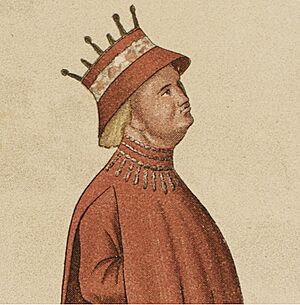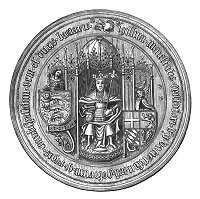Christopher of Bavaria facts for kids
Quick facts for kids Christopher |
|
|---|---|
 |
|
| King of Denmark (more...) | |
| Reign | 9 April 1440 – 5 January 1448 |
| Coronation | 1 January 1443 Ribe Cathedral |
| Predecessor | Eric VII |
| Successor | Christian I |
| King of Sweden | |
| Reign | 1441 – 5 January 1448 |
| Coronation | 13 September 1441 in Uppsala |
| Predecessor | Eric XIII |
| Successor | Charles VIII |
| King of Norway | |
| Reign | June 1442 – 5 January 1448 |
| Coronation | 2 July 1442 in Oslo |
| Predecessor | Eric III |
| Successor | Charles I |
| Count of Palatinate-Neumarkt | |
| Reign | 1443–1448 |
| Predecessor | John, Count Palatine of Neumarkt |
| Successor | Wolfgang of the Palatinate |
| Born | 26 February 1416 Neumarkt in der Oberpfalz |
| Died | 5/6 January 1448 (aged 31) Helsingborg |
| Burial | Roskilde Cathedral, Roskilde |
| Spouse |
Dorothea of Brandenburg
(m. 1445) |
| House | Palatinate-Neumarkt |
| Father | John, Count Palatine of Neumarkt |
| Mother | Catherine of Pomerania |
Christopher of Bavaria (born February 26, 1416 – died January 5 or 6, 1448) was a very important king in Scandinavia. He ruled as King of Denmark (from 1440), King of Sweden (from 1441), and King of Norway (from 1442). These three countries were united at the time under something called the Kalmar Union.
Contents
Biography
Becoming King of Three Nations
Christopher was born in a place called Neumarkt in der Oberpfalz in Bavaria, Germany. His father was John, Count Palatine of Neumarkt, and his mother was Catherine of Pomerania, Countess Palatine of Neumarkt. Catherine was the sister of Eric of Pomerania, who was the king of Denmark, Sweden, and Norway before Christopher.
In 1439, King Eric of Pomerania was removed from power in Denmark and Sweden. Christopher, who was Eric's nephew, was chosen by the Danish State Council to become the new ruler. He started as a regent (someone who rules for a king) in 1439. Then, on April 9, 1440, he was officially made King of Denmark.
Some people thought Christopher would be easy to control. But he managed to keep some power for himself. His rule helped create a balance between the king's power and the power of the nobles, which lasted for a long time. He was later chosen as King of Sweden in 1441 and King of Norway in June 1442.
Christopher even used a special title for himself: arch king. He believed he ruled a large empire, not just three separate countries. In 1445, Christopher married Dorothea of Brandenburg in Copenhagen.
Putting Down Peasant Rebellions
Early in his reign, Christopher faced big challenges. There were peasant rebellions in different parts of Denmark, like Funen and Jutland. These were farmers and common people fighting against the nobles.
One major uprising happened in North Jutland. About 25,000 peasants, led by Henrik Tagesen Reventlow, were a serious threat. Before the king could act, the noble families of Jutland gathered their own army.
The peasants were clever. They built a huge fort using wagons and tried to trick the knights by hiding a bog (a muddy area) with branches and earth. On May 3, 1441, the knights charged, but their horses got stuck in the bog. Many knights were killed, and the peasants even took over a important manor called Aalborghus.
This made King Christopher determined to stop the rebellions. He led his own army north. He offered a deal: if peasants left the rebel camp and went home, they wouldn't be punished. Some left, but many stayed. On June 8, 1441, Christopher's heavily armed knights attacked the rebel camp. Thousands of rebels were killed. Those who survived had to pay large fines. Even worse, many lost their freedom and became serfs, meaning they were tied to the land they worked. The king also made a rule that peasants could not carry long weapons.
Coronation and Challenges with Sweden
In May 1442, Christopher met with nobles from all three kingdoms in Lödöse. He was officially elected King of Norway there. Then he traveled to Oslo and was crowned on July 2, 1442. The next year, he was also declared King of Denmark near Ribe.
When his home in Roskilde burned down, Christopher moved his main residence to Copenhagen. He made Copenhagen the permanent capital of Denmark in 1443.
The Swedish nobles were not very happy with Christopher. They felt he was too German and didn't like that he let his uncle, the former King Eric, cause trouble by robbing ships from his castle on Gotland. They even blamed him for bad harvests, which caused people to be very hungry. People in Sweden started calling him the "Bark King" because they had to mix ground tree bark with flour to make bread.
Despite these challenges, Christopher tried to help cities and merchants. He worked to balance the power between the king and the nobles. However, he died suddenly before he could fully achieve his goals.
Death of the King
In 1448, Christopher died suddenly in Helsingborg. He was only 31 years old. King Christopher was buried in Roskilde Cathedral. His wife, Dorothea of Brandenburg, later married the next king of Denmark, Christian I.
|
Christopher of Bavaria
House of Palatinate-Neumarkt
Cadet branch of the House of Wittelsbach
Born: 26 February 1416 Died: 6 January 1448 |
||
| Regnal titles | ||
|---|---|---|
| Vacant
Title last held by
Eric of Pomerania |
King of Denmark 1440–1448 |
Vacant
Title next held by
Christian I |
| King of Sweden 1441–1448 |
Vacant
Title next held by
Charles VIII & I |
|
| King of Norway 1442–1448 |
||
| Preceded by John |
Count Palatine of Neumarkt 1443–1448 |
Succeeded by Otto I |
See also
 In Spanish: Cristóbal de Baviera para niños
In Spanish: Cristóbal de Baviera para niños



